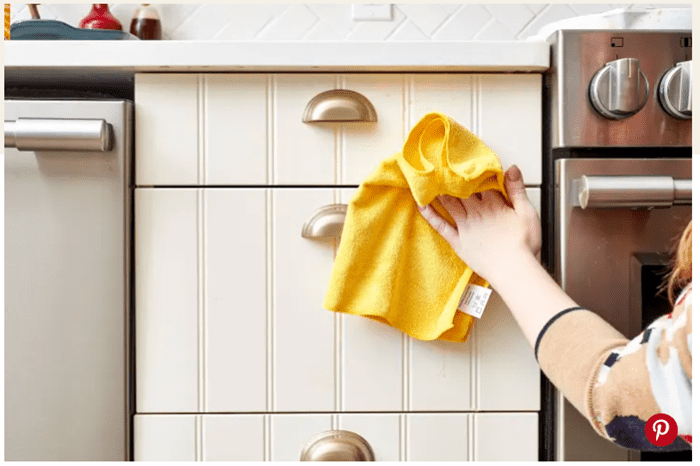Homeowners spend considerable time in their kitchen preparing meals, washing utensils, or doing other chores. Thanks to these activities in the kitchen, you may begin to see your cabinets getting stained with grease, spills, and water stains.
To keep your kitchen cabinets looking as good as new, you must adopt a self-cleaning mode. Cleaning also helps to increase the longevity of your cabinet doors.

Source: foodal.com
With the cost of installing new cabinets ranging from $2,000 to $26,000, many homeowners opt for thermofoil cabinets because they are slightly cheaper. They are also an alternative to natural wood and painted cabinet doors.
Consequently, taking good care of your thermofoil cabinets proves to be worthwhile in the end. Thankfully, cleaning thermofoil cabinetry requires little effort.
Let me take you through how to clean your thermofoil cabinet doors and take care of them.
JUMP TO: Steps to Clean Thermofoil Cabinet | How to Disinfect Thermofoil Surface | How Often Should I Clean Cabinet Doors
Key Takeaway
- Thermofoil cabinets require dust-wiping at least weekly.
- They also require a thorough cleaning at least once a month
- Use a non-abrasive cloth or sponge for cleaning. You can also use a paper towel.
- The cleaning might take 30 minutes to one hour, depending on how dirty your cabinet is.
- After cleaning, leave the cabinet to dry for 2-3 hours, then return the contents
How to Clean Thermofoil Cabinets Step-by-Step

Source: pinterest.com
What You Will Require
- standard household all-purpose cleaner
- a mixture of mild soap and water
- a non-abrasive cloth or sponge
- a clean damp cloth
- a clean microfiber cloth
Also Read: Pros and Cons of Thermofoil Cabinets
The Process
1. First, wipe your cabinets with a dry cloth to remove dust.
Tip: Wiping your cabinet should be a weekly task. However, do it whenever your cabinet gets spills, dust, or splatters.
2. Use a soft cloth or sponge to wash the cabinet doors. Ensure the sponge is non-abrasive and is suitable for use on vinyl.
This washing is essential in removing dirt, stains, or sticky substances. Use a circular motion when rubbing sticky stains to dislodge them easily.
3. Use a clean damp cloth to rinse your cabinet. This process ensures the cabinet surface is clean and shiny.
4. You can dry the cabinet using a microfiber cloth.
When cleaning your thermofoil cabinetry, observe the following points:
- Do not spray the cleaning solution directly on the cabinet surface. Spray it on a sponge, cloth, or paper towel and use it to wipe the cabinet surface.
- Many homeowners prefer using a paper towel because it is smooth and friendly to the cabinet surface.
- A damp paper towel on your cabinet surface after cleaning helps remove any leftover residue and cleaning solution.
Pressure Washing
It involves cleaning your cabinet using a high-pressure water jet. This method is effective, especially in removing stubborn dirt.
However, do not hold the pressure water jet too close to the cabinet’s surface. If it’s too close, it might discolor your cabinet’s surface.
When cleaning thermofoil cabinets, avoid the following cleaners:
- Abrasive cleaners
- Solvent-based cleaners
- Harsh chemicals
- Cleaners that combine with brushes
- Cleaners with ammonia
- Baking Soda
Important note: If you spill harsh chemicals on the thermofoil surface by mistake, wipe it immediately. After wiping, use soapy water to wash the surface, then rinse it several times with clean water.
Cleaning Grease stains

Source: bobvila.com
Your cabinet will always become greasy thanks to its proximity to the stovetop. Moreover, every time you touch the cabinet, either to open or close it, you risk greasing them.
Consequently, it would help if you degreased your thermofoil cabinet from time to time.
How do you remove greasy residue from thermofoil kitchen cabinet doors?
According to many homeowners, using a degreasing agent or cleaner is the best option. You can find them easily in your local hardware store.
Also Read:
Some of the best degreasing cleaners include:
- Parker & Bailey cabinet cream
- Miracle Wipes for wood surfaces
- Green Gobbler Orange Oil
- Krud Cutter
Many homeowners prefer them because they:
- They cut through grease easily
- Some give your cabinet a sweet smell
- They are non-toxic and hence safe for use on any surface
- They work instantly, removing stains and spots
To clean grease from thermofoil cabinet doors, follow the steps below:
Step 1: Apply a 50/50 mixture of water and cleaning agent onto a cloth.
Step 2: Scrub the greasy area gently for 10 or 20 strokes. This step is enough to remove most unstubborn grease stains. However, if the grease stains persist, move on to the next step.
Step 3: Apply Buckeye Workout to a damp cloth or sponge, then wipe the greased area slightly. Wipe in a circular motion for 10 to 20 strokes.
If the grease isn’t yet out completely, move to step 4.
Step 4: Wet a cloth or sponge with 70% Isopropyl Alcohol. Place it on top of the stain for 30 minutes, then remove it and wipe the place.
This step should remove any stubborn stain from your thermofoil cabinetry. Moreover, Isopropyl Alcohol does not leave any residue on your cabinet surface.
Also Read: How to Fix Peeling Thermofoil Cabinets?
How to Disinfect Thermofoil Surfaces
Even as you clean your thermofoil cabinets, remember that they have some dark corners. Stale crumbs, germs, and creepy crawlies tend to inhabit such corners.
However, you can make these corners as clean as the cabinet surface with some time and a few household products.
The best time to disinfect your thermofoil cabinets is when they are empty. You can do it when you move into a new house, or immediately buy them.
To disinfect, you only need a mixture of 90% water and 10% bleach.
However, before using it, ensure you test the mixture on an inconspicuous spot.
How Often Should I Clean My Cabinet Doors?
There’s not a definite frequency for cleaning your thermofoil cabinets. This will mostly depend on factors such as the proximity to the stovetop or the area you live in.
However, the rule of thumb is that you should wipe your thermofoil cabinets at least once a week to get rid of any dust. For cleaning, do it at least once a month to avoid dirt from accumulating.
![Painted Vs. Thermofoil Cabinets [Explained with Pros + Cons] Painted Vs. Thermofoil Cabinets [Explained with Pros + Cons]](https://houseadorable.com/wp-content/uploads/2022/09/Thermofoil-Kitchen-Cabinets-Are-Better-Than-Wood.jpg)

![Pros and Cons of Thermofoil Cabinets + Drawers [Explained] Pros and Cons of Thermofoil Cabinets + Drawers [Explained]](https://houseadorable.com/wp-content/uploads/2022/09/thermofoil.jpg)
![How Long Do Thermofoil Cabinets Last? [Factors Explained] How Long Do Thermofoil Cabinets Last? [Factors Explained]](https://houseadorable.com/wp-content/uploads/2022/09/thermo-1.jpg)
![How To Clean Grease Off Laminate Kitchen Cabinets? [Full Guide] How To Clean Grease Off Laminate Kitchen Cabinets? [Full Guide]](https://houseadorable.com/wp-content/uploads/2022/06/cleaning-cabinets-cover.jpg)
![What Is Kitchen Cabinet Refacing? [Pros and Cons + Cost Analysis] What Is Kitchen Cabinet Refacing? [Pros and Cons + Cost Analysis]](https://houseadorable.com/wp-content/uploads/2022/04/Refacing.jpg)
![How to Fix Peeling Thermofoil Cabinets? [Explained in 5 Simple Steps] How to Fix Peeling Thermofoil Cabinets? [Explained in 5 Simple Steps]](https://houseadorable.com/wp-content/uploads/2022/08/49aa0b2c1af4ed2592479ad036bb055b.jpg)
![Wood Cutting Board Vs. Plastic Board [Which is Safer?] Wood Cutting Board Vs. Plastic Board [Which is Safer?]](https://houseadorable.com/wp-content/uploads/2023/01/wood-board.jpg)